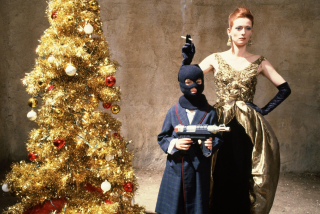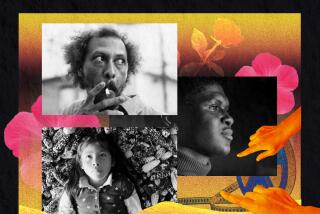A Master of Action and Reaction
- Share via
The UCLA Film Archives’ “Nitrate Walsh,” a series of notable Raoul Walsh films, commences tonight at 7:30 in Melnitz Hall’s James Bridges Theater with the rarely seen “Regeneration” (1915) and the gangster classic (and TV staple) “The Roaring Twenties” (1939). Walsh was a dynamic, expressive director, a master of action, who had a gift for revealing emotional vulnerability in even his roughest, toughest heroes. This was a constant throughout his long career; it is as true of “Regeneration” as it was of “The Roaring Twenties” and beyond.
Adapted by Walsh and actor Carl Harbaugh from the book and play “My Mamie Rose” by Owen Kildare, “Regeneration” is one of many silent films of its day that documented harsh New York tenement life and found melodrama in its hardships. The material of this William Fox production is much like the others, yet Walsh brought to “Regeneration” a passionate intensity that makes it riveting still.
Rockliffe Fellowes stars as a young gang leader transformed by an elegant, upper-class woman (Anna Q. Nilsson) who has exchanged her life in high society for work in a settlement house. This is particularly perplexing to her beau, the district attorney (Harbaugh) who has declared war on the gangs. The redeemed Fellowes’ past catches up with him, and he faces wrenching, though ultimately affirmative, consequences. Walsh makes you forget the lurid plotting and connect with Fellowes and his pain--and his enchantment with the lovely and intelligent Nilsson.
“The Roaring Twenties” is a sure-fire epic tale of three hard-up World War I vets (James Cagney, Humphrey Bogart and Jeffrey Lynn) who turn to bootlegging. The focal point is Cagney’s dramatic rise and even more dramatic fall, played against turbulent times. The film’s ending is among the movies’ most unforgettable, one in which naked emotion surely would have slipped into shameless heart-tugging in lesser hands.
Information: (310) 206-8599.
*
The Laemmle Theaters’ World Cinema 2000 series continues with Srdjan Dragojevic’s “The Wounds” (Monica 4-Plex, Saturday and Sunday at 11 a.m.), a caustic slapstick tragedy in the same vein as the director’s equally savage--and often cruelly funny--”Pretty Village, Pretty Flame.” Set in a chaotic and corrupt Belgrade between 1991 and 1996, it moves back and forth in time to chart the coming of age of two boys, the saturnine Pinki (Dusan Pekic) and his pal, the deceptively innocent-looking Kraut (Milan Maric). In a desperate world of few alternatives, these two easily become swept up in a life of crime.
For Dragojevic, they become symbolic of a lost generation, too young to experience a society that acknowledges the value of distinguishing between right and wrong. As the boys careen into a lethal existence of violence, drugs, alcohol and sex, they become increasingly numb until they are unable to feel anything except pain. Surreal comic sequences heighten the lethal absurdity of the boys’ existence, such as Pinki’s introducing his elderly grandmother to the pleasures of cocaine--”a new remedy for sinus trouble.” “The Wounds” is another major work from a major director. (310) 394-9741. “The Wounds” screens Oct. 7-8 at 10 a.m. at the Sunset 5, (323) 848-3500; and Oct. 14-15 at 11 a.m. at the Playhouse 7, Pasadena.
Information: (626) 844-6500.
*
France’s prodigious Leos Carax combines the sweeping, fatalistic romanticism of the traditional classics of the French cinema with the passion, energy and go-for-broke experimentation of the New Wave. Carax will be present for the sneak preview of “Pola X,” which stars Guillaume Depardieu and Catherine Deneuve, at the Egyptian on Saturday at 6 p.m.
“Pola X” launches the American Cinematheque’s “Modern Love: The Films of Leos Carax,” which will be followed at 9:30 p.m. by his 1984 debut film “Boy Meets Girl,” a darkly lyrical film shot in a ravishing black and white and starring a Carax favorite, Denis Lavant, a sensitive yet volatile ragamuffin of a man. His Alex is steeped in isolation and despair when he encounters the exquisite but self-destructive Mireille (Mireille Perrier).
Sunday at 5 p.m. brings a revival of “The Lovers on the Bridge” (1991), which played Los Angeles recently, in which Lavant returns as Alex, more Chaplinesque than ever, who encounters another troubled beauty (Juliette Binoche) while living on Paris’ Pont-Neuf during its reconstruction.
It will be followed at 8 p.m. by “Bad Blood,” in which Lavant’s Alex, a street magician, is recruited by a gang leader (Michel Piccoli) to take his late father’s place in a heist. The take is a lab culture of a virus that is much deadlier and easier to transmit than AIDS. It’s in a French laboratory, but an American pharmaceutical company is eager to use it to produce a lucrative antidote. The virus remains symbolic: It attacks those “who make love without feeling”; the big issue is Alex’s attraction to the gang leader’s loyal young lover (Binoche). Carax’s films are heady stuff but have terrific impact for those open to them.
Information: (323) 466-FILM.
*
Veteran documentarian Mel Stuart’s bracing and affectionate “Running on the Sun” covers 1999’s annual Badwater 135, a grueling three-day race, among the world’s most difficult. It begins in Death Valley in 115-degree heat, at an altitude of minus 282 feet and ends 8,400 feet up Mt. Whitney. It is a contest in which age and experience can triumph over youth, and past winners will have a tough time repeating their success. Two men, both of whom have lost part of their right legs--one of them part of his right arm as well--will strive simply to finish.
One of the first to throw in the towel, overcome by dehydration and failing kidneys, would seem the least likely: a fit young Marine major who recovers to urge on others to complete the course. The oldest racers are two men, 68 and 64, and the oldest woman is 56. They are all likable, unpretentious people. Some of them can put into words why they’re racing; others find it beyond their powers of expression.
Kirk Johnson, a New York Times editor, competing in honor of his late brother, a runner, sees the race as an ultimate reaction against postindustrial society, and that seems a good general explanation for an experience that for participants seems ultimately mystical, a deep communion with nature and self. Opens Friday, exclusively at the Westside Pavilion, West Los Angeles, through Oct. 5.
Information: (310) 475-0202.
More to Read
Only good movies
Get the Indie Focus newsletter, Mark Olsen's weekly guide to the world of cinema.
You may occasionally receive promotional content from the Los Angeles Times.










